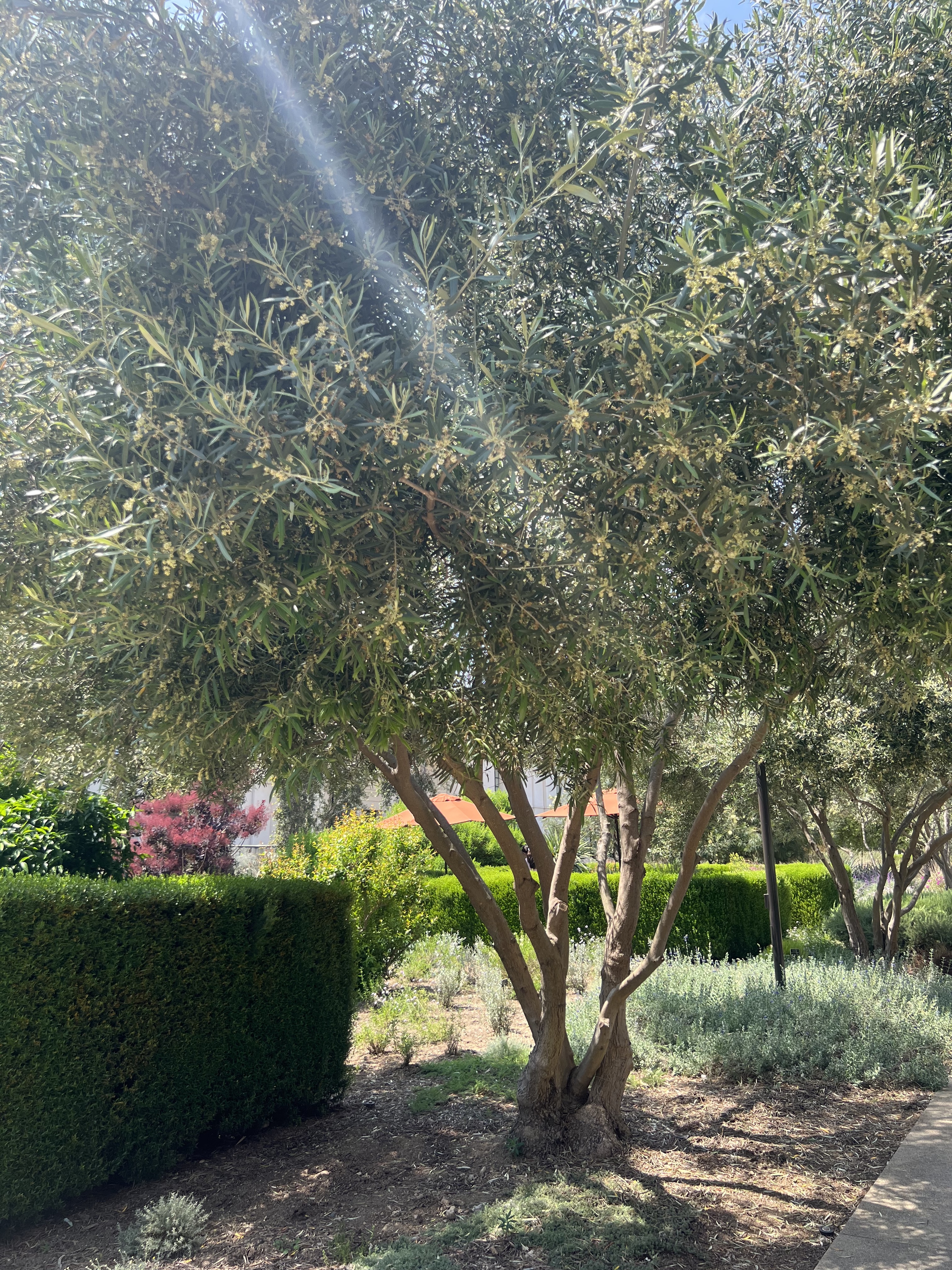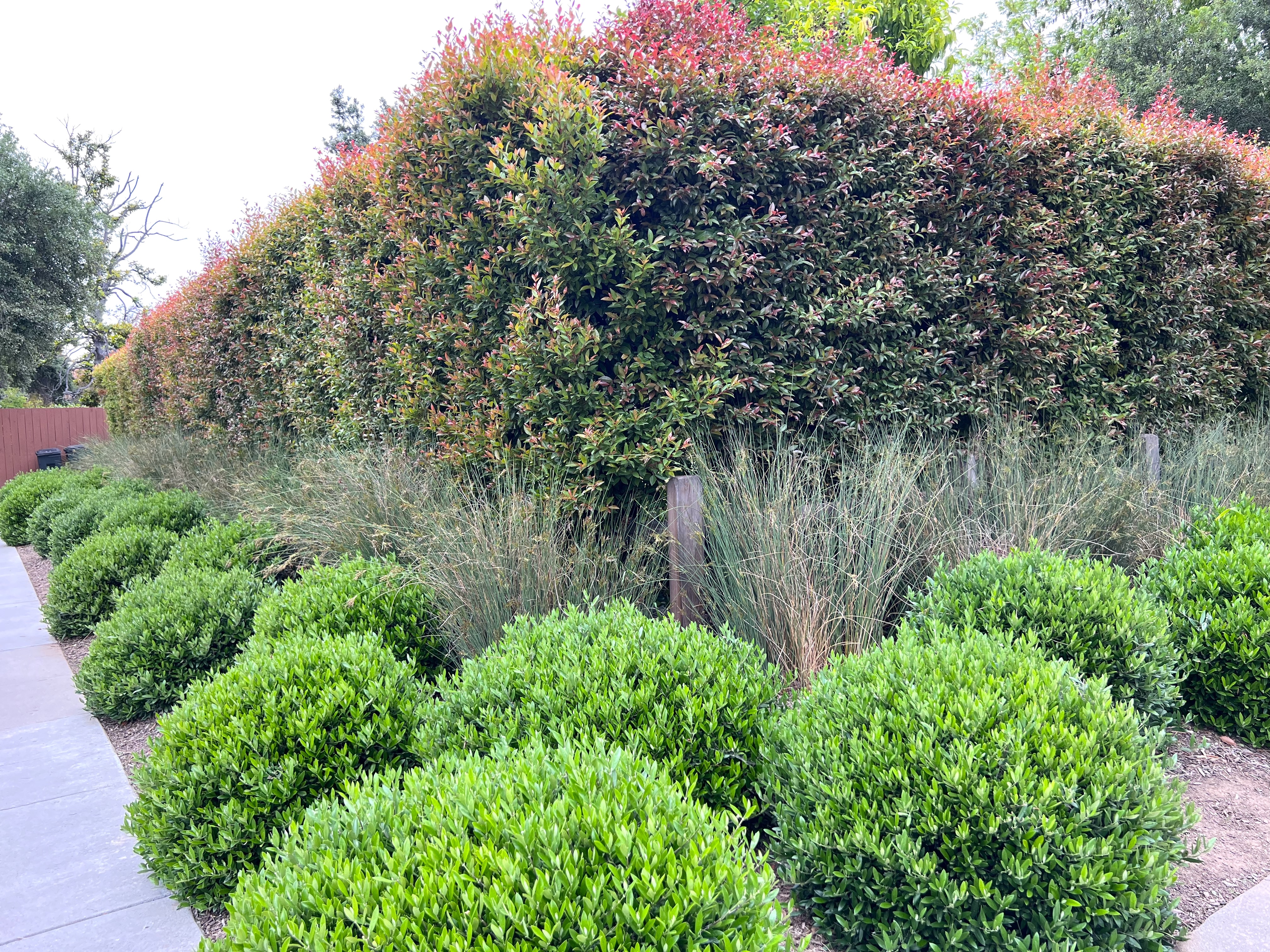
Ah, the allure of the privacy hedge! This sight truly evokes that quintessential LA vibe, a sentiment that I’ve always found myself daydreaming about. There’s an undeniable charm in the idea of being completely enveloped by a lush green wall. Given the bustling lifestyle in the city, it’s remarkable how people find ingenious ways to carve out their own private oasis. While on the quest for the perfect privacy hedge, I found it surprisingly challenging to locate my favored sweet bay laurel online, inspiring me to create a comprehensive catalog of all the hedge varieties I encounter throughout Los Angeles.
This list has just started and will continue to grow. I find it exhilarating to think that I’ll continue to expand this collection, adding more captivating finds as I keep exploring and stumble upon more such hedges. Such is the joy and mystery of urban gardening!
My Favorite Southern California Nursery
If you are in the socal area I’ve purchased a majority of my plants from moon valley nurseries and I highly recommend their moon juice fertilizer. My sweet bay hedge have just exploded in growth this spring, I’m excited to see them by the end of summer! Ok so here’s the list of different types of hedges for privacy. I will continuously update it as I see more privacy hedges out in the wild.
Table of contents
FAST GROWING PRIVACY HEDGES
MODERATE GROWING PRIVACY HEDGES
FAST GROWING
Bougainvillea
- Light needs: Full sun
- Mature height: 15-40 feet
- Ideal growing zone: 9-11
- Flowering: Yes
- 3-5 Feet per year

FAST GROWING
Bougainvillea Care
- Water regularly but let the soil dry out between waterings.
- Fertilize regularly during the growing season.
- Provide support as this plant loves to climb.
- Prune to control size and shape.

FAST GROWING
Japanese Privet
Ligustrum Japonicum
- Grows up to 2 ft per year
- Light needs: Full sun to partial shade
- Mature height: 10-12 feet
- Ideal growing zone: 7-10
- Flowering: Yes

FAST GROWING
Japanese Privet Care
- Water regularly, especially during dry periods.
- Prune as needed to maintain the desired shape.
- Apply a balanced 10-10-10 fertilizer in the spring.

FAST GROWING
Algerian Ivy
- 3 ft per year
- Light needs: Partial to full shade
- Mature height: 10-20 feet
- Ideal growing zone: 7-10
- Flowering: No

FAST GROWING
Algerian Ivy Care
- Water regularly, especially in dry periods.
- Prune to control growth and create desired shape.
- It can be invasive, so monitor its spread.

MODERATE GROWTH
Crimson Bottlebrush
Callistemon
- Light needs: Full sun
- Mature height: 10-15 feet
- Ideal growing zone: 8-11
- Flowering: Yes

MODERATE GROWTH
Bottle Brush Care
- Water deeply but not too frequently.
- Prune after flowering to encourage dense growth.
- Fertilize in spring and early fall with a balanced 10-10-10 fertilizer.

MODERATE GROWTH
Star Jasmin
- Light needs: Full sun to partial shade
- Mature height: 20-30 feet
- Ideal growing zone: 8-10
- Flowering: Yes

MODERATE GROWTH
Star Jasmin Care
- Water regularly, but do not allow the soil to become waterlogged.
- Prune after flowering to maintain shape.
- Fertilize in the spring with a 10-10-10 balanced fertilizer.

MODERATE TO SLOW
Standard Olive
- Grows 1-2 Feet Per year
- Light needs: Full sun
- Mature height: 20-30 feet
- Ideal growing zone: 8-10
- Flowering: Yes

MODERATE TO SLOW
Standard Olive Care
- Water regularly but let the soil dry out between waterings. This plant is drought-tolerant once established.
- Prune as needed to maintain the desired shape.
- Fertilize in spring with a low nitrogen fertilizer, such as a 5-10-10.

MODERATE GROWTH
Brush Cherry
- Light needs: Full sun to partial shade
- Mature height: 10-20 feet
- Ideal growing zone: 9-11
- Flowering: Yes

MODERATE GROWTH
Brush Cherry Care
- Water regularly but do not allow the soil to become waterlogged.
- Prune to maintain desired shape.
- Fertilize in spring with a balanced 10-10-10 fertilizer.

MODERATE GROWTH
Carolina Cherry Laurel
- Light needs: Full sun to partial shade
- Mature height: 15-20 feet
- Ideal growing zone: 7-10
- Flowering: Yes

MODERATE GROWTH
Carolina Cherry Laurel Care
- Water regularly, especially during dry periods.
- Prune to maintain desired shape.
- Fertilize in early spring with a balanced 10-10-10 fertilizer.

MODERATE GROWTH
Japanese Pittosporum
- Grows 1 Ft per year
- Light needs: Full sun to partial shade
- Mature height: 10-12 feet
- Ideal growing zone: 8-10
- Flowering: Yes

MODERATE GROWTH
Japanese Pittosporum Care
- Water regularly, but do not allow soil to become waterlogged.
- Prune to maintain the desired shape.
- Apply a balanced 10-10-10 fertilizer in spring.

SLOW GROWING PRIVACY HEDGES
SLOW GROWING
Olea Europaea Montra “Little Ollie”
- Light needs: Full sun to partial shade
- Mature height: 4-6 feet
- Ideal growing zone: 8-11
- Flowering: No

SLOW GROWING
Little Ollie Care
- Water regularly but let the soil dry out between waterings. This plant is drought-tolerant once established.
- Prune as needed to maintain the desired shape.
- Fertilize in spring with a low nitrogen fertilizer, such as a 5-10-10.

Having Trouble Finding what you need? Consider Buying Privacy Hedges Online
- Certainly, here’s your revised text with added transition words:
- Introduction: Encountering difficulties while searching for the right privacy hedges? Well, consider buying privacy hedges online, which might just be the ideal solution you need.
- Choosing a Seller: Firstly, start your journey by selecting a reputable online nursery or garden center. Look for those with positive reviews and a diverse range of healthy plants that suit your specific needs.
- Understanding Product Descriptions: After you’ve settled on a reliable seller, focus on understanding product descriptions next. Be diligent and ensure the hedge you choose is suitable for Zone A/B and perfectly aligns with your specific requirements.
- Reviewing Shipping Policy: Following that, delve into the seller’s shipping policy. You want to verify that your plants will be delivered at the optimum time for planting in your area.
- Size and Quantity: Subsequently, take the time to evaluate the size and quantity of plants you require. This step is crucial in order to create an effective privacy screen.
- Customer Feedback: Once you’ve figured out your needs, shift your attention to customer feedback and ratings. This invaluable information can provide insight into the quality and reliability of the online seller.
Care and Maintenance
However, once your new hedges are securely in place and start to thrive, it’s vitally important not to let the sheer joy and excitement of this successful transformation eclipse the fundamental requirement of continuous care and maintenance.
To begin with, the initial stages after planting are pivotal, and it’s at this juncture that regular watering becomes a key ingredient to help the new plants establish their roots securely in their new environment. As the roots take hold, the plant can start absorbing the necessary nutrients from the soil, essential for its growth and survival.
Subsequently, after this initial phase, the need for regular watering doesn’t simply disappear. On the contrary, a consistent watering schedule plays an even more significant role in keeping your hedges hydrated and healthy. Each species has its own specific watering needs and meeting them ensures the plant continues to flourish.
The Importance of Deep Watering
Building upon the topic of regular watering, it’s crucial to highlight the importance of deep watering, a practice that goes beyond merely moistening the surface of the soil. This method, which encourages water to penetrate deep into the soil, is not just beneficial, but essential for robust plant growth.
Primarily, deep watering promotes the growth of deeper roots, extending further into the soil. This greater depth allows plants to access water reserves that aren’t immediately available to surface roots, enhancing their resilience during dry periods.
Subsequently, as roots delve deeper into the soil, the plants become more stable and anchored, better equipped to withstand winds and storms. This stability is especially important for hedges, which are often exposed to harsh weather.
Progressively moving from the initial stages of planting to the plant’s mature life, understanding and maintaining the rhythm of care is crucial. Over time, this regular attention and consistent watering become second nature, part of a rhythm that ties the gardener to their garden.
Ultimately, regular watering, coupled with other necessary care like fertilizing, pruning, and disease control, lays the foundation for a vibrant and resilient hedge that not only provides privacy but also enhances the overall aesthetics of your landscape.”
Additionally, fertilizing plays a crucial role in providing the essential nutrients for the growth of your hedges. Timing your fertilizer application accurately, typically in early spring, can encourage robust growth and enhance the overall health and appearance of your hedges.
Pruning Your Hedges
Moreover, the importance of regular pruning extends far beyond merely maintaining the shape and size of your hedges. In fact, it serves as a catalyst for denser growth, transforming your hedges into lush, full, and vibrant borders. This can not only add a significant aesthetic appeal to your garden, but it also enhances the functionality of your privacy hedge, making it a visually striking barrier against the outside world.
Pruning isn’t merely a tool for enhancement though. Indeed, it’s also a preventative measure that helps ward off diseases. By improving airflow within the hedge, it helps to keep the interior of your plants dry and less susceptible to fungal diseases, a common bane for dense foliage.
Timing is Key When Pruning
But the art and science of pruning don’t stop at the mere act. Instead, timing also plays a critical role. Ideally, you should prune your hedges in late winter or early spring when they are dormant. This timing allows your hedges to focus their energy on producing new growth when they come out of dormancy, enhancing their spring revival.
Next, the technique of pruning is also a factor to consider. Aim for a slightly tapered shape, with the base of the hedge wider than the top. This form ensures that sunlight reaches the lower branches, promoting even growth throughout the hedge and maintaining the fullness at all levels.
Of course, while pursuing the perfect prune, cleanliness is key. Always remember to clean your pruning tools before and after use. This practice is a surefire way to prevent the spread of diseases between plants. You certainly don’t want to unwittingly become the carrier of disease in your own garden.
Plant Health Is Essential
For a deeper dive into plant health, check out our article on “Yellowing Leaves in Plants: Identifying and Addressing Common Plant Health Issues.” Lastly, if you’re new to gardening or looking to up your game, don’t miss our useful guide, “Essential Tools Every Newbie Gardener Needs: A Comprehensive Guide.” This handy resource can help you select the right tools to make your gardening tasks more efficient, enjoyable, and successful.








Leave a Reply